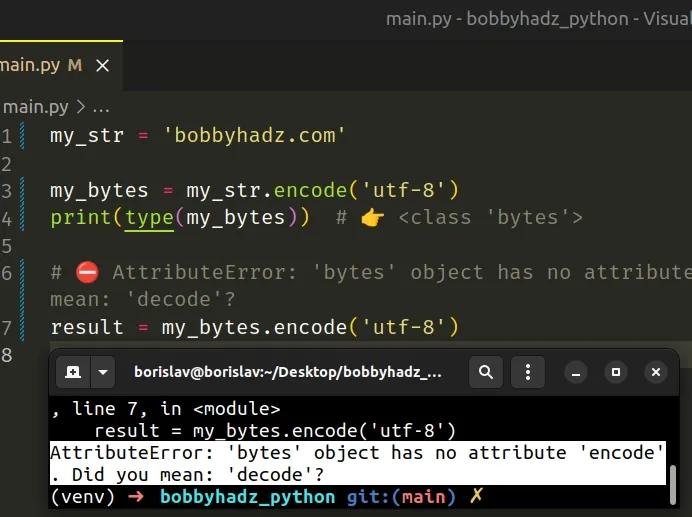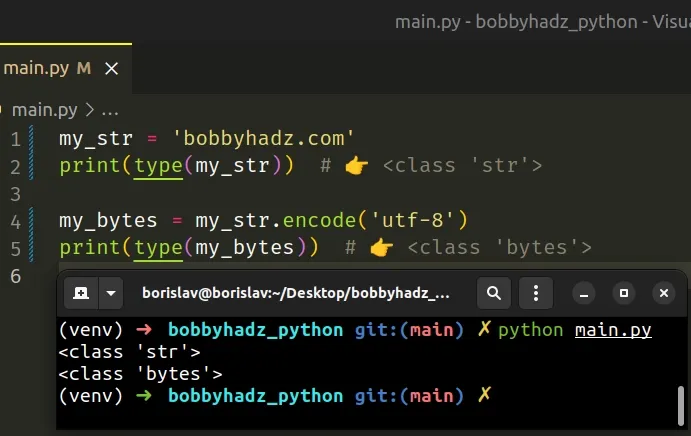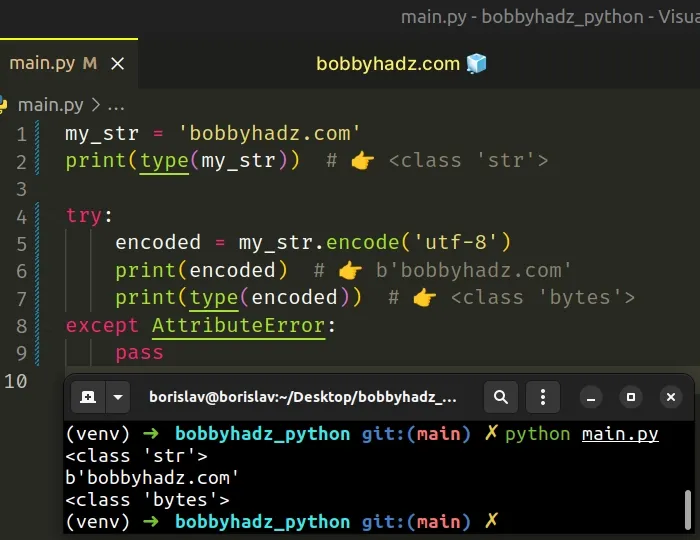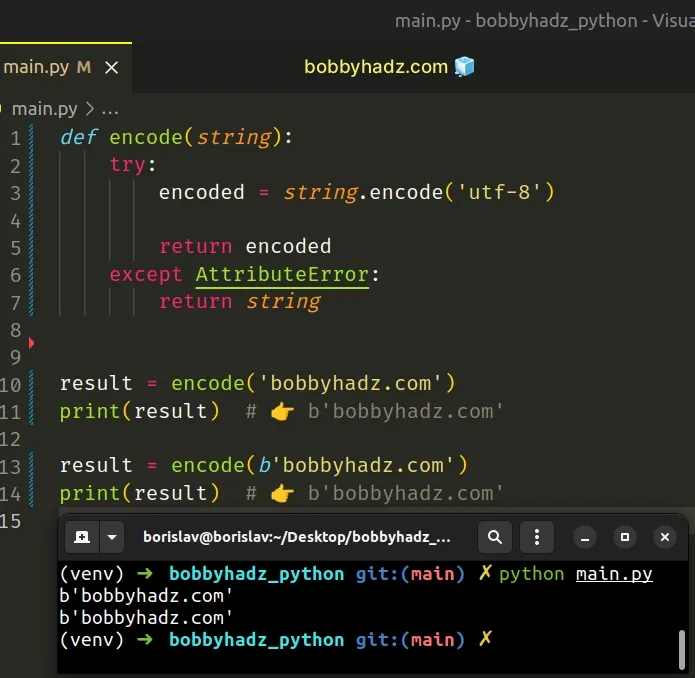AttributeError: 'bytes' object has no attribute 'encode'
Last updated: Apr 8, 2024
Reading time·4 min

# AttributeError: 'bytes' object has no attribute 'encode'
The Python "AttributeError: 'bytes' object has no attribute 'encode'" occurs
when we call the encode() method on a bytes object.
To solve the error, remove the call to the encode() method as the variable
already stores a bytes object.

Here is an example of how the error occurs.
my_str = 'bobbyhadz.com' my_bytes = my_str.encode('utf-8') print(type(my_bytes)) # 👉️ <class 'bytes'> # ⛔️ AttributeError: 'bytes' object has no attribute 'encode'. Did you mean: 'decode'? result = my_bytes.encode('utf-8')

The issue in the code sample is that we are trying to encode a bytes object.
string to a bytes object and decoding is the process of converting a bytes object to a string.# You don't have to call the encode() method on bytes objects
To solve the error, remove the call to the encode() method.
my_str = 'bobbyhadz.com' print(type(my_str)) # 👉️ <class 'str'> my_bytes = my_str.encode('utf-8') print(type(my_bytes)) # 👉️ <class 'bytes'>

The encode() method is used to convert a string to bytes, so the method cannot
be called on a bytes object.
# Using a try/except statement to handle the error
If you aren't sure whether you have a bytes object or a string, use a
try/except statement to
handle the possible AttributeError.
my_str = 'bobbyhadz.com' print(type(my_str)) # 👉️ <class 'str'> try: encoded = my_str.encode('utf-8') print(encoded) # 👉️ b'bobbyhadz.com' print(type(encoded)) # 👉️ <class 'bytes'> except AttributeError: pass

We try to encode the value and if it doesn't have an encode() attribute (it's
not a string), we handle the AttributeError.
# Creating a reusable function that handles the error
You can also extract the logic into a reusable function.
def encode(string): try: encoded = string.encode('utf-8') return encoded except AttributeError: return string result = encode('bobbyhadz.com') print(result) # 👉️ b'bobbyhadz.com' result = encode(b'bobbyhadz.com') print(result) # 👉️ b'bobbyhadz.com'

The function tries to encode the passed-in value to a bytes object and if an
AttributeError is raised, the value is returned as is.
string to a bytes object and decoding is the process of converting a bytes object to a string.# Checking for the type of the variable before calling encode()
An alternative approach is to use an if statement to check for the type of the
variable before you call the encode() method.
def encode(string): if isinstance(string, str): encoded = string.encode('utf-8') return encoded else: return string result = encode('bobbyhadz.com') print(result) # 👉️ b'bobbyhadz.com' result = encode(b'bobbyhadz.com') print(result) # 👉️ b'bobbyhadz.com'

The if statement checks if the supplied value has a type of string.
If the value is a string, we called the encode() method to convert the string
to bytes.
Otherwise, we return the value as is.
# Using str.encode() vs bytes.decode()
You can use the str.encode() method to go from str to bytes and
bytes.decode() to go from bytes to str.
my_text = 'bobbyhadz.com' my_binary_data = my_text.encode('utf-8') print(my_binary_data) # 👉️ b'bobbyhadz.com' my_text_again = my_binary_data.decode('utf-8') print(my_text_again) # 👉️ 'bobbyhadz.com'
The str.encode() method is the
opposite of bytes.decode() and returns a bytes representation of the Unicode
string, encoded in the requested encoding.
# Using the bytes() and str() classes instead
You can also use bytes(s, encoding=...) and str(b, encoding=...).
my_text = 'bobbyhadz.com' my_binary_data = bytes(my_text, encoding='utf-8') print(my_binary_data) # 👉️ b'bobbyhadz.com' my_text_again = str(my_binary_data, encoding='utf-8') print(my_text_again) # 👉️ 'bobbyhadz.com'
The str() class returns a string version of the given object. If an object is not provided, the class returns an empty string.
The syntax for using the
bytes() class is
the same, except that a b prefix is added.
# Python 3 uses the concept of text and binary data
Ever since Python 3, the language uses the concepts of text and binary data instead of Unicode strings and 8-bit strings.
All text in Python is Unicode, however, encoded Unicode is represented as binary data.
You can use the str type to store text and the bytes type to store binary
data.
u'...' literals for Unicode text because all strings are now Unicode.However, you must use b'...' literals for binary data.
A good way to start debugging is to print(dir(your_object)) and see what
attributes a string has.
# Checking what type a variable stores
If you aren't sure what type a variable stores, use the type() class.
my_str = 'bobbyhadz.com' print(type(my_str)) # 👉️ <class 'str'> print(isinstance(my_str, str)) # 👉️ True my_bytes = b'bobbyhadz.com' print(type(my_bytes)) # 👉️ <class 'bytes'> print(isinstance(my_bytes, bytes)) # 👉️ True
The type class returns the type of an object.
The isinstance() function
returns True if the passed-in object is an instance or a subclass of the
passed-in class.
# Printing the attributes of a bytes object
Here is an example of what printing the attributes of a bytes object looks
like.
my_bytes = b'bobbyhadz.com' # ['__add__', '__class__', '__contains__', '__delattr__', '__dir__', '__doc__', '__eq__', '__format__', '__ge__', '__getattribute__', '__getitem__', '__getnewargs__', '__gt__', '__hash__', '__init__', '__init_subclass__', '__iter__', '__le__', '__len__', '__lt__', '__mod__', '__mul__', '__ne__', '__new__', '__reduce__', '__reduce_ex__', '__repr__', '__rmod__', '__rmul__', '__setattr__', '__sizeof__', '__str__', '__subclasshook__', 'capitalize', 'center', 'count', 'decode', 'endswith', 'expandtabs', 'find', 'fromhex', 'hex', 'index', 'isalnum', 'isalpha', 'isascii', 'isdigit', 'islower', 'isspace', 'istitle', 'isupper', 'join', 'ljust', 'lower', 'lstrip', 'maketrans', 'partition', 'removeprefix', 'removesuffix', 'replace', 'rfind', 'rindex', 'rjust', 'rpartition', 'rsplit', 'rstrip', 'split', 'splitlines', 'startswith', 'strip', 'swapcase', 'title', 'translate', 'upper', 'zfill'] print(dir(my_bytes))
If you pass a class to the dir() function, it returns a list of names of the class's attributes, and recursively of the attributes of its bases.
Since encode() is not a method implemented by bytes objects, the error is
caused.

